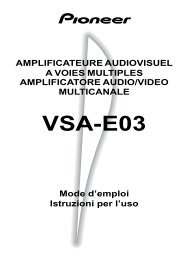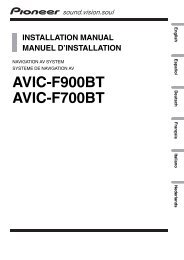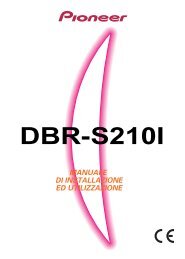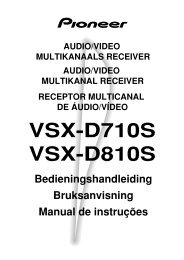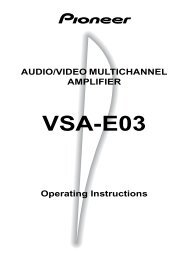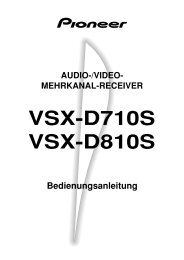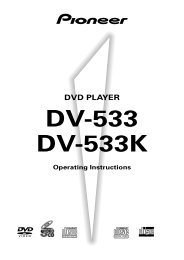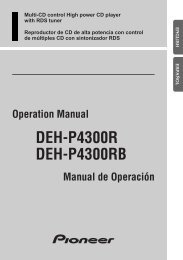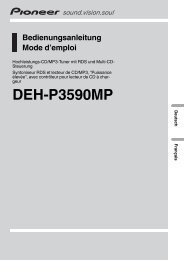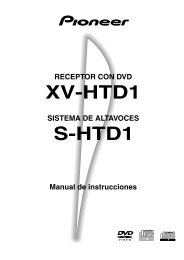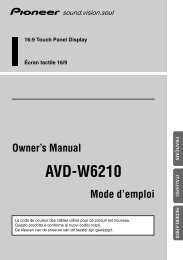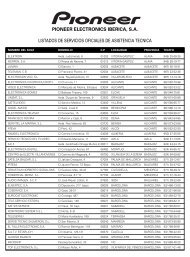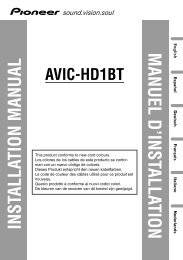DV-K102 DVD-V550 - Service.pioneer-eur.com - Pioneer
DV-K102 DVD-V550 - Service.pioneer-eur.com - Pioneer
DV-K102 DVD-V550 - Service.pioneer-eur.com - Pioneer
Create successful ePaper yourself
Turn your PDF publications into a flip-book with our unique Google optimized e-Paper software.
Differences in Disc<br />
Composition<br />
<strong>DV</strong>D<br />
<strong>DV</strong>Ds are divided into units referred to as titles, and<br />
titles are divided into chapters. A <strong>DV</strong>D which contains a<br />
movie may have only one title with many or no chapter<br />
divisions. Karaoke <strong>DV</strong>Ds may have many titles, assigning<br />
a title to each song on the disc. Menu screens do not<br />
belong to any title.<br />
<strong>DV</strong>D player functions generally apply to titles on a disc or<br />
chapters within a selected title. The player functions<br />
available may also vary from title to title, depending on<br />
the disc. When discs have a unique title division, it<br />
should be noted that search and program functions may<br />
be affected.<br />
Title 1<br />
Chapter 1 Chapter 2<br />
Title 2<br />
Chapter 1 Chapter 2<br />
How to Proceed in This<br />
Manual<br />
<strong>DV</strong>D is an incredible format that presents the highest<br />
quality digital audio and video available today.<br />
Because using the <strong>DV</strong>D player and <strong>DV</strong>Ds may be<br />
confusing at first, following the order below should help<br />
you get through the important stages of getting set up<br />
so you can start using your player as soon as possible.<br />
Get familiar with the player.<br />
Refer to the section “Before Using” on page 8 to<br />
confirm that all the accessories were included with the<br />
player. If you are new to <strong>DV</strong>D, it might be beneficial for<br />
you to go through the “Names and Functions” section<br />
starting on page 10 to get familiar with the parts and<br />
buttons on the main unit and remote control as they will<br />
be referred to throughout this manual.<br />
There is also a list of terms that can be found on page 58<br />
if you are having trouble understanding some of the<br />
terminology associated with <strong>DV</strong>D.<br />
Make the necessary connections.<br />
<strong>DV</strong>D<br />
Super VCD/Video CD/CD<br />
Super VCDs, Video CDs and CDs are divided into units<br />
referred to as tracks (Super VCDs and Video CD tracks<br />
may also be referred to as scenes). One song generally<br />
corresponds to one track. Some tracks are further<br />
divided into units referred to as indexes. Super VCDs/<br />
Video CDs with PBC (Playback Control) also contain<br />
menus recorded on the disc which enable easy access<br />
to the contents of the disc.<br />
When played back on a <strong>DV</strong>D player, Super VCDs, Video<br />
CDs and CDs are considered to be a single title,<br />
regardless of the number of tracks.<br />
Track 1 Track 2 Track 3 Track 4<br />
Super VCD/Video CD<br />
Track 1 Track 2 Track 3 Track 4 Track 5<br />
CD<br />
No entertainment system seems to be set up exactly<br />
the same way. The “Making Connections” section<br />
starting on page 16 shows how video and audio<br />
connections may be made to suit your home<br />
entertainment system.<br />
Set up the player.<br />
Before you can begin to enjoy the benefits of the <strong>DV</strong>D<br />
format, you should set up the player to output the video<br />
and audio information that corresponds to your system.<br />
The section “Setting Up the Player” starting on page 19<br />
explains how to use the Setup Navigator, a function that<br />
automatically sets up the player corresponding to the<br />
answers given in a multiple-choice on-screen procedure.<br />
The Setup screen menus, described in the section<br />
starting on page 26, are also used in a number of other<br />
functions. Learning the procedure for operating the<br />
menus will make using this player much easier and more<br />
enjoyable.<br />
Play a disc.<br />
When all the connections and setups have been made,<br />
you are ready to play a <strong>DV</strong>D, Super VCD/Video CD, or CD<br />
with the player. The section “Getting Started Using Your<br />
<strong>DV</strong>D Player” starting on page 22 outlines the basic<br />
player operations.<br />
Enjoy the many features available.<br />
Once you are <strong>com</strong>fortable using the basic player<br />
functions, you are ready to take advantage of the various<br />
options <strong>DV</strong>D and this player have to offer. The section<br />
“Advanced Functions” starting on page 42 describes<br />
how to use the features available on many <strong>DV</strong>Ds.<br />
6



